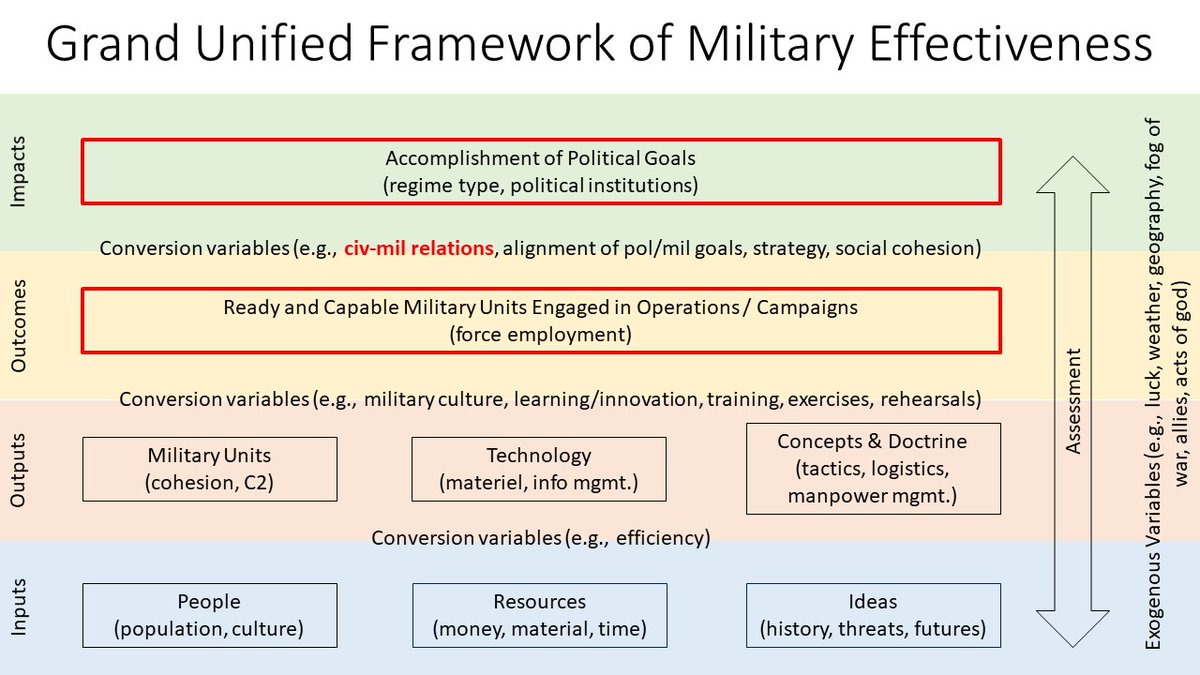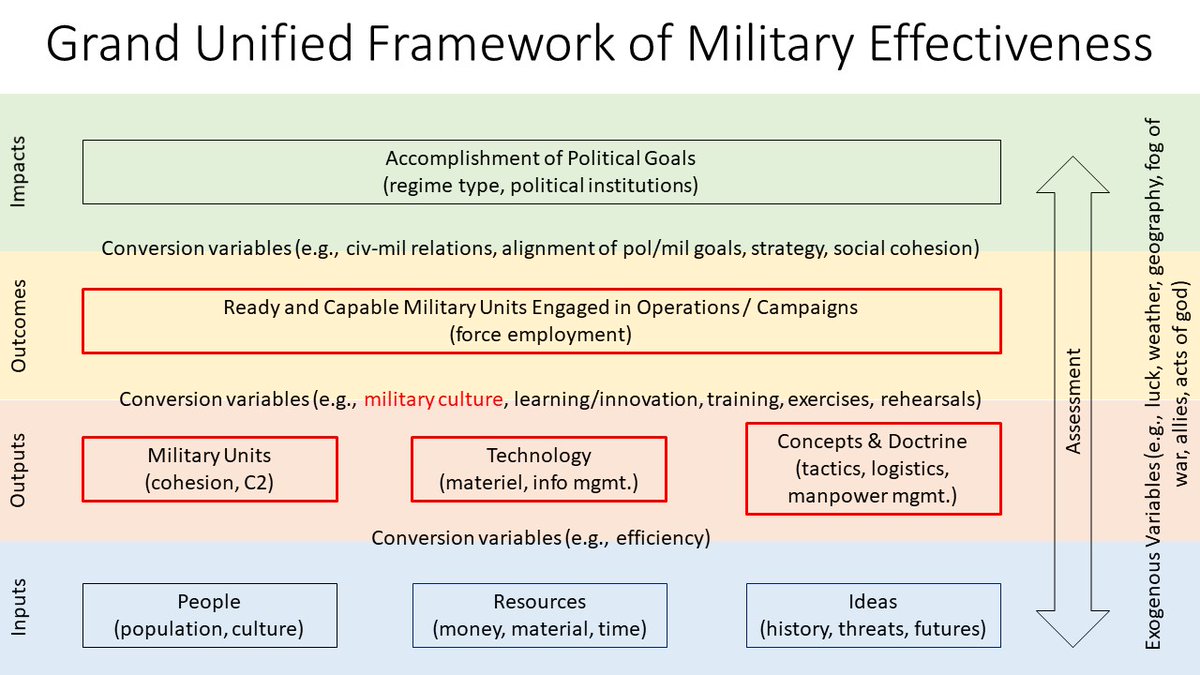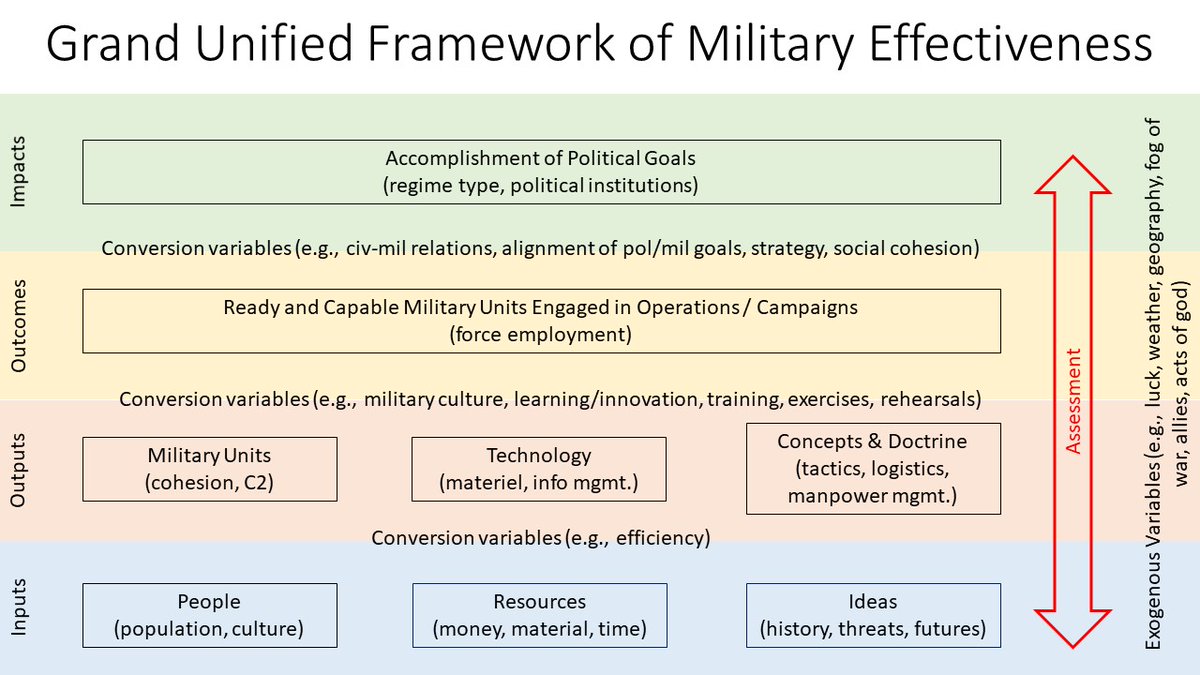1/n
Reading: Jacob Weisberg, “Gulfballs: How the Experts Blew It, Big-Time,” New Republic 204, no. 12 (March 25, 1991), pp. 17-19. 2/n
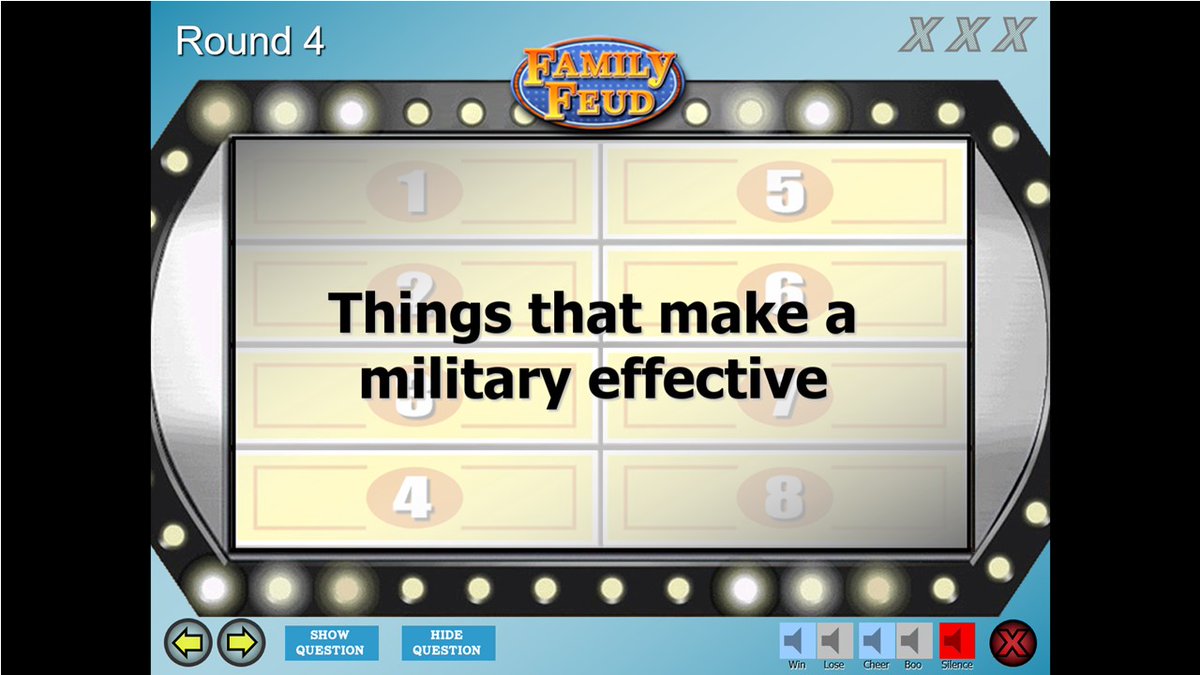
1. Allen R. Millett & Williamson Murray, Military Effectiveness, Vol. 1 (Cambridge: Cambridge University Press, 2010), Chap 1.
2. Stephen Biddle, Military Power: Explaining Victory & Defeat in Modern Battle (Princeton, N.J.: Princeton University Press, 2004), p. 5-9 4/n
We ended by pulling together the various elements of effectiveness we discussed into a "grand unified framework" to guide the rest of the course 7/n
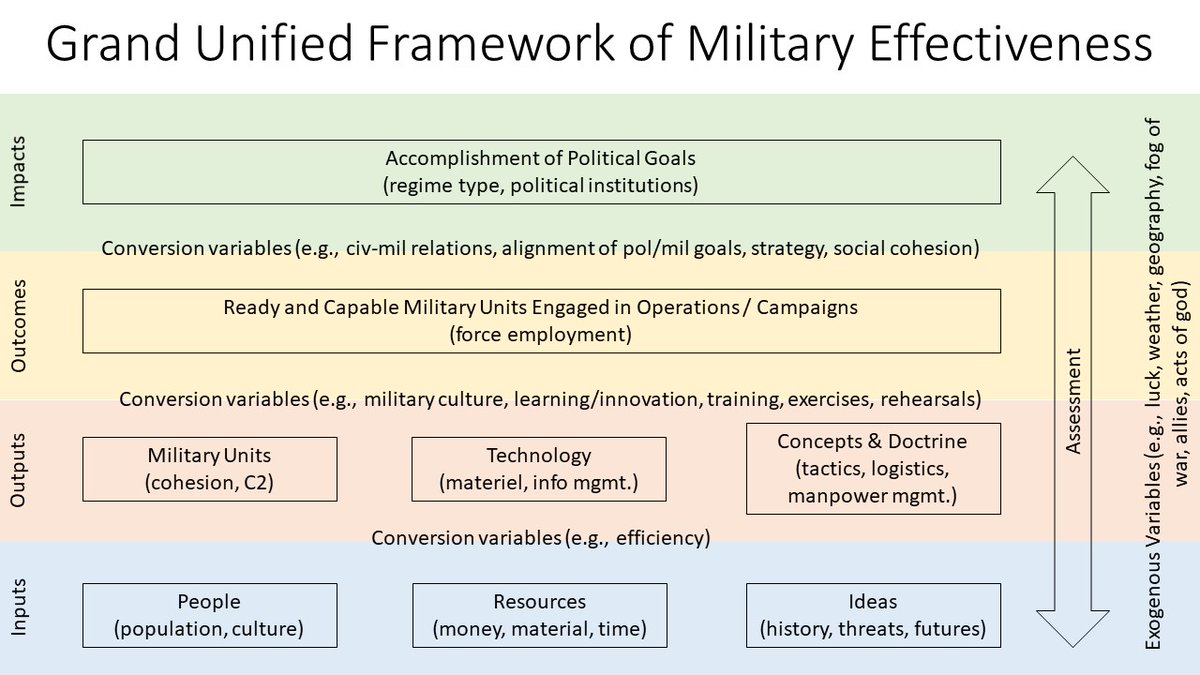
We also played the SHOWCASE SHOWDOWN! 8/n

1. John J. Mearsheimer, “Assessing the Conventional Balance: The 3:1 Rule and Its Critics,” Int'l Security 13, no. 4 (Spring 1989): 54-89.
2. John W.R. Lepingwell, “The Laws of Combat? Lanchester Reexamined,” Int'l Security 12, no. 1 (Summer 1987): pp. 89-134. 9/n
10/n
11/n
1. @USGAO, “Defense Strategy: Revised Analytic Approach Needed to Support Force Structure Decision-Making,” GAO-19-385, March 2019. gao.gov/products/GAO-1…
12/n
13/n
Next week: Military Resources!
14/n
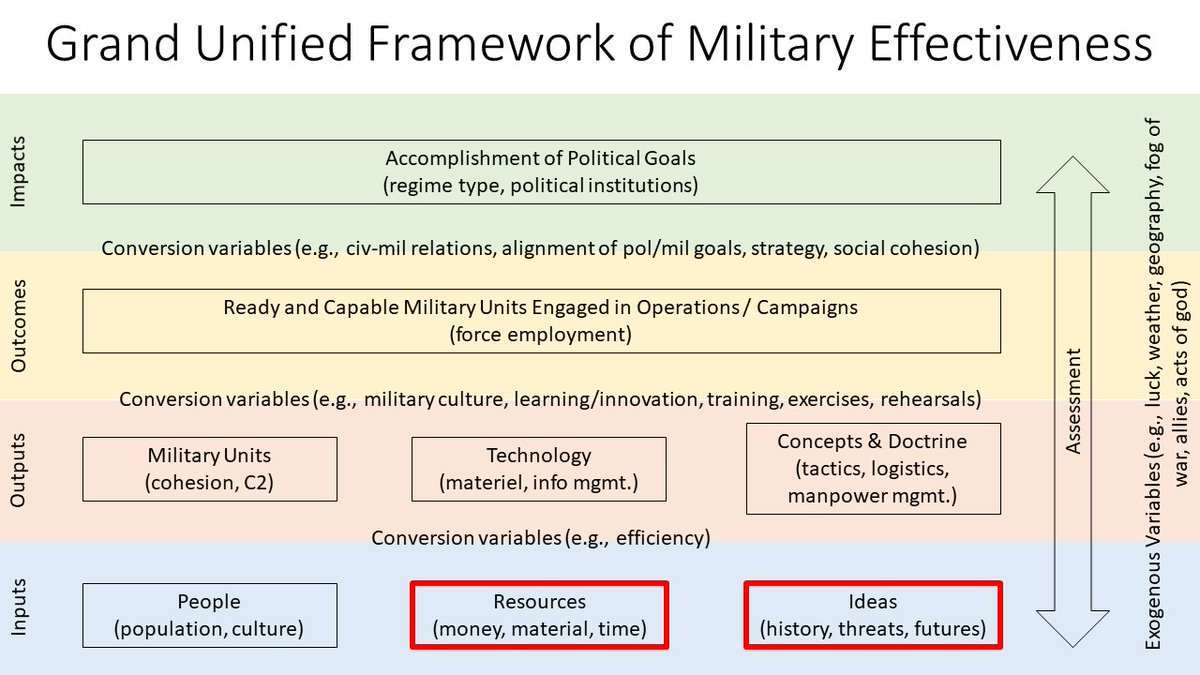
1. John J. Mearsheimer, The Tragedy of Great Power Politics (New York: Norton, 2001), Chap 3.
2. Barry R. Posen, “Measuring the European Conventional Balance: Coping w/Complexity in Threat Assessment,” Int'l Security 9, no. 3 (Winter 1984/85): pp. 47-88. 16/n
1. Charles L. Glaser and Chaim Kaufmann, “What Is the Offense-Defense Balance and How Can We Measure It?” International Security 22, no. 4 (Spring 1998): pp. 44-82.
Next week: Force Employment!
19/n
John J. Mearsheimer, Conventional Deterrence (Ithaca, N.Y.: Cornell Univ Press, 1983), Chap 2.
Stephen Biddle, Military Power: Explaining Victory and Defeat in Modern Battle (Princeton, N.J.: Princeton Univ Press, 2004).
Next wk: COIN & Special Ops! 21/n
And the class was kind enough to bear w/my cold. 22/n
- David Galula, Counterinsurgency Warfare: Theory & Practice (Westport, CT: Praeger Security Int'l), Chaps 4 & 5.
- William H. McRaven, The Theory of Special Operations (Monterey, CA: Naval Postgraduate School, 1993), Chaps 1 & 10.
Next week: Regime Type! 23/n
Required readings:
- Dan Reiter & Allan C. Stam, Democracies at War (Princeton, N.J.: Princeton Univ Press, 2002), Chaps 2-3 24/n
- Alexander B. Downes, “How Smart and Tough Are Democracies? Reassessing Theories of Democratic Victory,” Int'l Sec 33, no 4 (Spring 2009): 7-51 25/n
- Jonathan D. Caverley, “The Myth of Military Myopia: Democracy, Small Wars, and Vietnam,” International Security 34, no. 3 (Winter 2009/10): pp. 119-57. 26/n
- Correspondence between Reiter and Stam and Downes in International Security 34, no. 2 (Fall 2009): pp. 194-204.
- Michael C. Desch, “Democracy and Victory: Why Regime Type Hardly Matters,” International Security 27, no. 2 (Fall 2002): pp. 5-47. 27/n
- Michael C. Desch, Power and Military Effectiveness: The Fallacy of Democratic Triumphalism (Balt, Md.: JHU Press, 2008). 28/n
Next week: Civ-Mil Relations!
29/n
- @RisaBrooks12, Shaping Strategy: The Civil-Military Politics of Strategic Assessment (Princeton, NJ: Princeton Univ Press, 2008).
31/n
32/n
- Ulrich Pilster and Tobias Böhmelt, “Coup-Proofing and Military Effectiveness in Interstate Wars, 1967-99,” Conflict Management and Peace Science 28, no. 4 (2011): 331-50.
33/n
Next week: Military Culture!
34/n
- Austin Long, The Soul of Armies: Counterinsurgency Doctrine and Military Culture in the US and UK (Ithaca, NY: Cornell Univ Press, 2016), Chaps 1-4, 6-7, 9.
- Elizabeth Kier, Imagining War (Princeton, N.J.: Princeton Univ Press, 1997), pp. 27-32, 70-88. 36/n
- Andrew F. Krepinevich, The Army and Vietnam (Baltimore, Md.: Johns Hopkins University Press, 1986).
Next week is spring break. Then, Small Unit Cohesion!
38/n
- Edward Shils & Morris Janowitz, “Cohesion and Disintegration in the Wehrmacht in World War II,” Public Opinion Qrtly 12 no 2 (Summer 1948): 280-315
- Omer Bartov, Hitler’s Army: Soldiers, Nazis, and War in the Third Reich (NY:Oxford Univ Press, 1992) 29-58. 40/n
- Anthony King, “On Combat Effectiveness in the Infantry Platoon: Beyond the Primary Group Thesis,” Sec Studies 25, no 4 (Oct-Dec 2016): 699-728 42/n
- Robert Macoun, “What Is Known about Unit Cohesion and Military Performance,” in Sexual Orientation and U.S. Military Personnel Policy: Options and Assessment (Santa Monica, Calif.: @RANDCorporation, 1993), pp. 283-331. 44/n
Next week: Military Innovation & Adaptation!
46/n
- Adam Grissom, “The Future of Military Innovation Studies,” J of Strat Studies 29, no 5 (Oct 2006): 905-934.
- Barry Posen, Sources of Military Doctrine: France, Britain, & Germany between the World Wars, (Ithaca NY: Cornell U Press, 1984), Chaps 1-2. 48/n
49/n
- S. Griffin, “Military Innovation Studies: Multidisciplinary or Lacking Discipline?” J of Strat Studies 40, nos 1-2 (2017): 196-224
- R. Grauer, Commanding Military Power: Organizing for Victory & Defeat on the Battlefield (Cambridge U Press, 2016). 51/n
- Nina A. Kollars, “War’s Horizon: Soldier-Led Adaptation in Iraq and Vietnam,” Journal of Strategic Studies 38, no. 4 (2015): pp. 529-553. 52/n
Next week: Military Assessment!
53/n
- Scott Sigmund Gartner, Strategic Assessment in War (New Haven, CT: Yale University Press, 1997).
- Jonathan Schroden, “Measures for Security in a Counterinsurgency,” Journal of Strategic Studies 32, No. 5 (October 2009), pp. 715–744. 55/n
Recommended:
- DOD, Joint Pub 5-0: Joint Planning, June 16, 2017, Chap VI; read pp. VI-1 to VI-23, skim pp. VI-24 to VI-41. 56/n
Next week: Case study on the US in #Afghanistan (2001-present)!
57/n
- Cong Research Serv “Department of Defense Contractor and Troop Levels in Afghanistan and Iraq: 2007-2018” CRS Report R44116, May 10, 2019
- Megan Katt “Blurred Lines: Cultural Support Teams in Afghanistan” Joint Forces Qtrly 75 (4th Q 2014) p 106-113 59/n
- Austin Long, The Soul of Armies, Chapter 10. 60/n
- @and_huh_what, “Taliban Fragmentation: A Figment of Your Imagination?” @WarOnTheRocks, September 4, 2019. 61/n
- Thomas H. Johnson, “Taliban Adaptations and Innovations,” Small Wars and Insurgencies 24, No. 1 (2013), p 3-27 62/n
- Jonathan Schroden, “Military Pressure and Body Counts in Afghanistan,” @WarOnTheRocks, May 17, 2019. 63/n
Next week--last class: The future of military power & effectiveness! 64/n
- Jacquelyn Schneider, “The Capability/Vulnerability Paradox and Military Revolutions: Implications for Computing, Cyber, and the Onset of War,” Journal of Strategic Studies 42, No. 6 (2019), pp. 841-863. 66/n
- @RisaBrooks12, “Technology and Future War Will Test U.S. Civil-Military Relations,” @WarOnTheRocks, November 26, 2018. 67/n
- @Tmgneff & @MujMash, “In Afghanistan’s War and Peace, WhatsApp Delivers the Message,” @nytimes, October 26, 2019. 68/n
- @DonRassler, The Islamic State and Drones, @CTCWP, July 2018.
- Thomas Zeitzoff, “How Social Media is Changing Conflict,” Journal of Conflict Resolution (2017), pp. 1-22. 69/n

